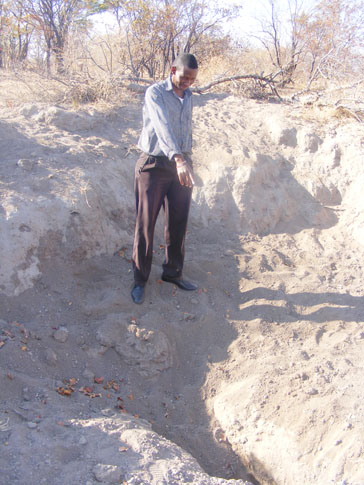Tracing Damochujenaa roots
28 Jul 2013
Some villages in the country get famous because residents are well known for some sporting activities or social achievements. But Damochujenaa, situated in the Mmadinare constituency a stone throw in the northerly direction of Serule/Selebi Phikwe road is popular but not from any of that sort. .
How Damochujenaa or Damochuo as it is affectionately known, gained popularity is anyone’s guess. Some would say the village gained popularity from its unique Sesarwa name. Others would say its “discovery” had a legacy.
But as the saying goes “water is a source of life and without water life could not exist”, seemingly this could also be aligned to a water hole that gave birth and life to a settlement that has come to be known as Damochujenaa.
If this water hole could not have been discovered by the Basarwa living in the area between late 1800 and early 1900, one might say the people who lived there today could be identifying themselves with another name or maybe, the village could be not have been established where it is today.
The name Damochujenaa according to the village kgosi Mr Motsholetsi Kebalipile, is a Sesarwa or Bushmen name that means - ‘Sedibana sa motho yo o seleme’ in Setswana and meaning a borehole that belongs to a person with a lisp or foreign language.
He said his father, Mr Gakebone Kebalipile leader of Basarwa of Damochujenaa born in 1914 and died in 1973, told him that the Basarwa were the first inhabitants of the area.
The kgosi said the history of Damochujenaa harks back to the late 1800 and early 1900 when Bangwato chief, Kgosi Khama III sent a certain mongwato man named Motswerenyane and his grandfather by the name of Moshakge (the father of Gakebone Kebalipile) also a bushman from Seleka in the Shoshong area to establish cattle posts near Damochujenaa at places called Sedibe and Boditela to herd his cattle and sheep.
He said since descendants of Moshakge were hunters and gatherers during those days, some village elders went out to gather wild fruits and roots. While they were harvesting wild fruits called ‘moretologa’, they came across a waterhole dug by an anteater (thakadu). After noticing the water source, they also saw some foot prints leading to the water hole and back again somewhere.
The group of people then decided to follow the trail and just after a short distance they discovered a dwelling place where they found a man living there. When they tried to communicate with the stranger they found out that he was speaking in a different language they did not understand.
However the stranger allowed them to harvest some water at the borehole after which they left the place and returned to their home at Sedibe cattle post some distance away. He said when they arrived at their home at Sedibe cattle post they told the rest of the clan including Motswerenyane and Moshakge that they found a waterhole that belonged to a person that spoke a different language.
Because they were speaking in the Sesarwa language what they said was “Da-mochu-jenaa” meaning “Sedibana sa motho yo o seleme” in Setswana and translated to “a water borehole that belongs to a person speaking a foreign language”.
He said from then on when people were away from Sedibe and Boditela cattle posts herding cattle and collecting wild fruits in the bush, they would pass by Damochujenaa water hole to quench their thirst. From that day up to today, the place was called Damochojenaa and residents of Sedibe and Boditela started to identify themselves and their village with the name Damochujenaa.
He said around 1973 when Kebalipile Gakebone passed away, his son Thaloso Kebalipile who is his elder brother (current kgosi Motsholetsi Kebalipile) moved from Sedibe cattle posts in the early 1970’s to Damochujenaa to start ploughing fields. Also his move was to settle closer to the road that leads from Serule to Selebi Phikwe mining town for easy access to goods and services.
He said it was then that some people from Sedibe and Boditela cattle posts moved to Damochujenaa also to start ploughing fields and the settlement started to grow.
Around the mid 1970’s when Mr Kebatlamang Morake was the area Member of Parliament until 1984 when the current Vice President Dr Ponatshego Kedikilwe became the area MP the population of Damochujenaa started to grow with people from other parts of Botswana such as Bangwato ,Babirwa, Bakalaka and Matebele settling there to plough fields and herd cattle.
However Mr Kebalipile said from 1984 up to 1989 the village elders and his brother engaged the area MP Dr Kedikilwe and dikgosi from villages such as Mmadinare to have their settlement recognized as a village. He said with the help of their MP Dr Kedikilwe, Damochujenaa was upgraded to a village in 1989.
He said when his brother Thaloso Kebalipe passed on in 1998, the village stayed without a leader for a while. He said because he was the only direct descendant of Moshakge who was his grandfather, people of Damochujenaa called on him to become the village kgosi and was ordained in 1999.
The village now has a number of developments. He said a school called Sedibe Primary School was established in his village in 1992. There is a clinic and some other offices that host Veterinary officers, Agricultural Demonstrators and a Social and Community Development Officers among other officers. In addition there is a customary court with a Headman of Records, police officers and a court clerk.
But soon this popular village will become more popular when at least 1000 beneficiaries of the poverty eradication programme descend on it from August 1 up to the 3rd to attend workshops designed to teach them life skills.
Various media houses will also cover the event to further promote Damochuo. It will be actually broadcast live on Radio Botswana and Botswana Television.
The workshops follow similar activities which were held at Chanoga, Diphuduhudu, Sehunou/Motshegaletau, Phuduhudu, Dikhukhung and Struizendam. It has been resolved that Gojwane and Serule will be encompassed in the Damochujenaa workshops as the Sehunou/Motshegaletau workshops somehow eluded them.
The Minister for Presidential Affairs and Public Administration Mokgweetsi Masisi said at a recent media briefing that the Vice President Dr Ponatshego Kedikilwe will officiate at the Damochujenaa Pitso. The Anglo American Head of Social Performance Mr Jonathan Samuel will also grace the event as the guest of honour.
Damochujenaa also is economically viable as there are some shops. It is ideal for arable production and there is a possibility that it can be a commercial phane harvesting area as it gets a lot of the lucrative worm during phane gathering seasons.
Residents are however worried that people from other villages always gather around Damochuo to harvest the worms leaving very little to continue the life circle of the nutritious protein rich delicacy.
He said some of the projects included backyard gardens, small stock and other alternative packages that were part of the poverty eradication exercise.
Kgosi Kebalepile said his village was ready to benefit from the projects as electricity was already available saying that they would like to be assisted with cattle as people were keen in pastoral farming.
The village leader said Damochujenaa was a melting pot of cultures as it has people of Kalanga, Shona, Sesarwa and Tswana origin, but that they all live in harmony despite their tribal differences.
Villagers have constructed modern houses and only a few mud huts are found in the village. The current population of the village is over 1170 people and according to Kgosi Kebalipile, the village is still growing as some people from around Botswana have shown interest in settling there, perhaps due its popularity.
One can safely say Damochujenaa village or just the name is well known in all the four corners of this country. “The name itself resonates and has that uniqueness. I have never been to that village but I imagine a wonderful place,” said one resident of Toteng in the North West District. ENDS
Source : BOPA
Author : Kesaobaka Kooreng and Tshepo Mongwa
Location : SELEBI PHIKWE
Event : Features
Date : 28 Jul 2013






